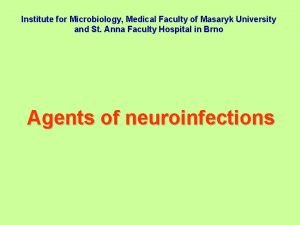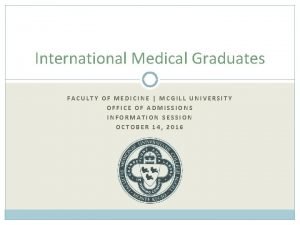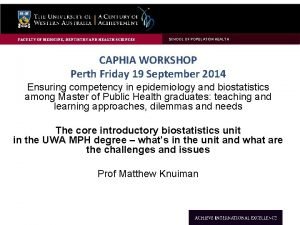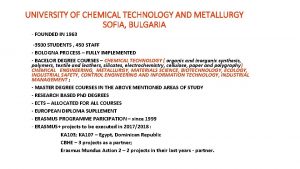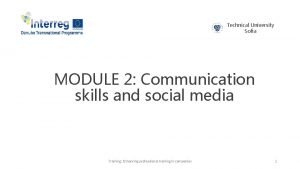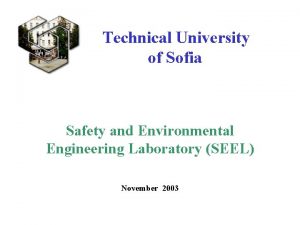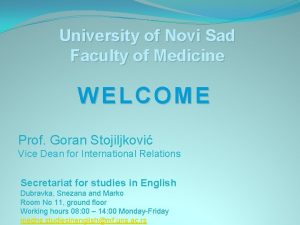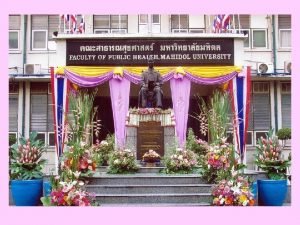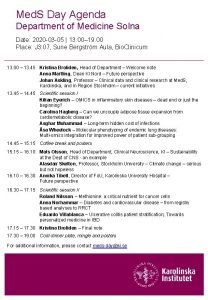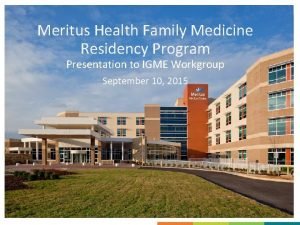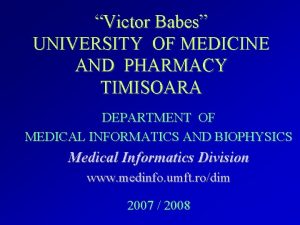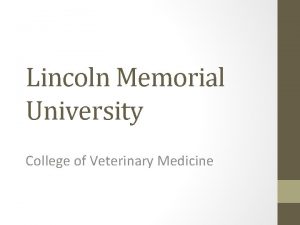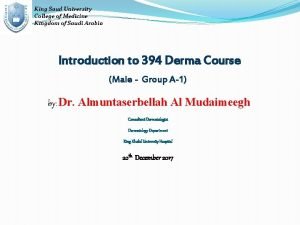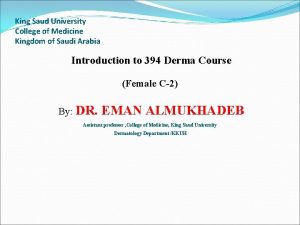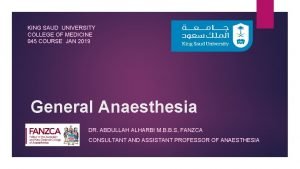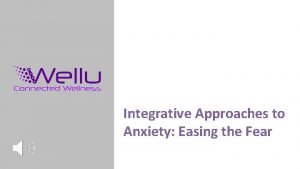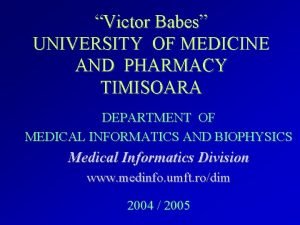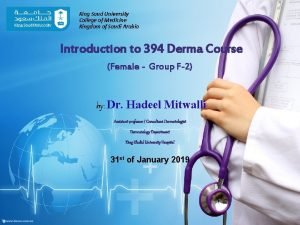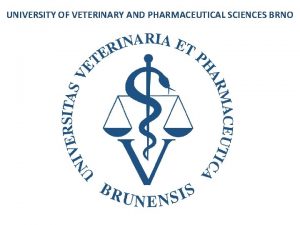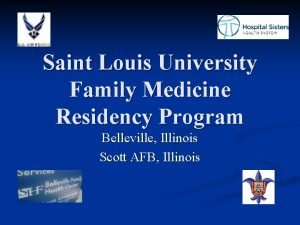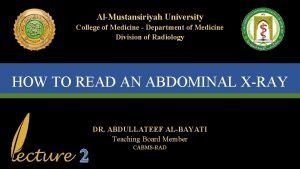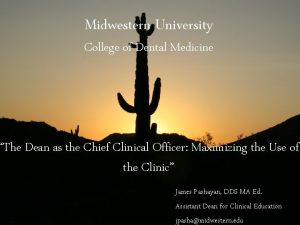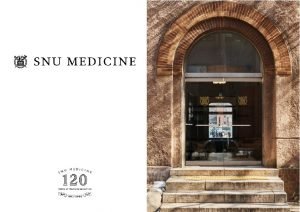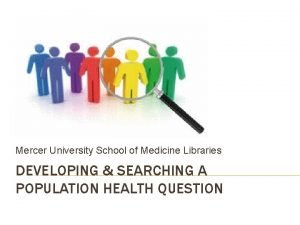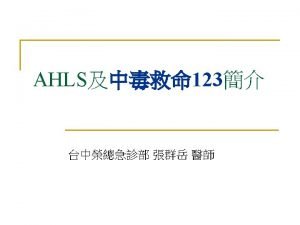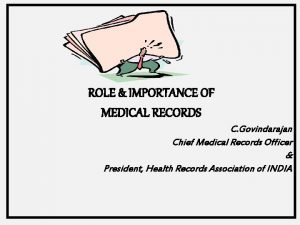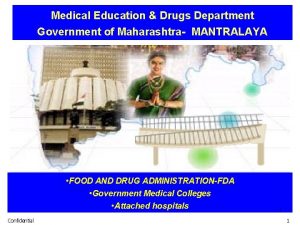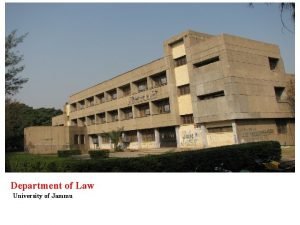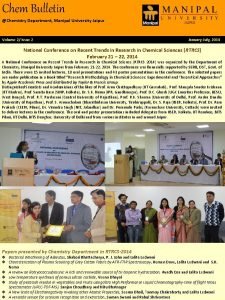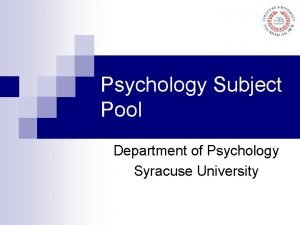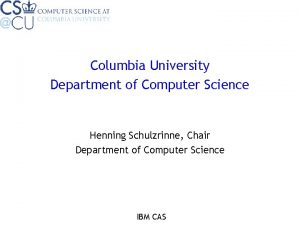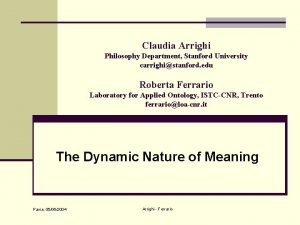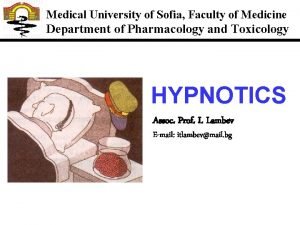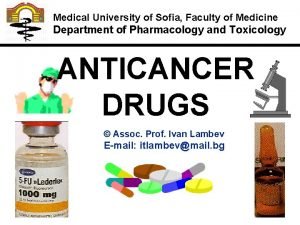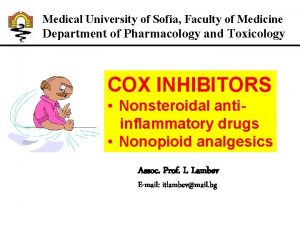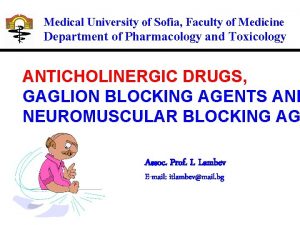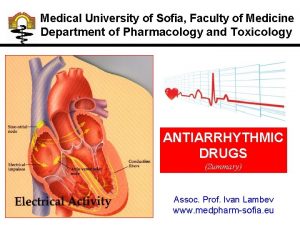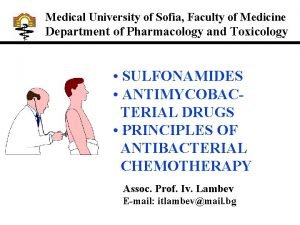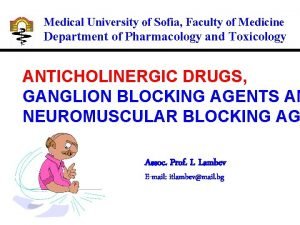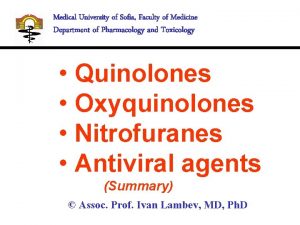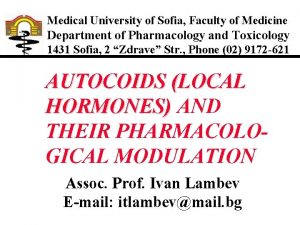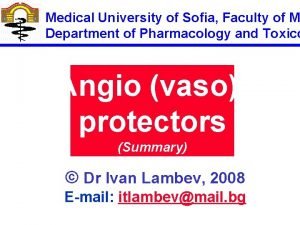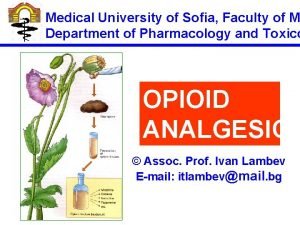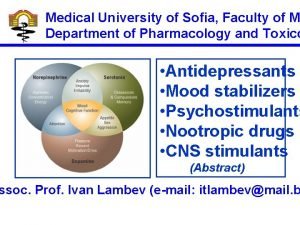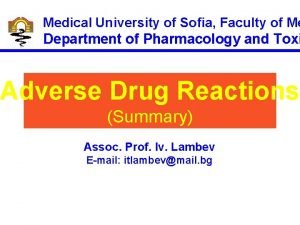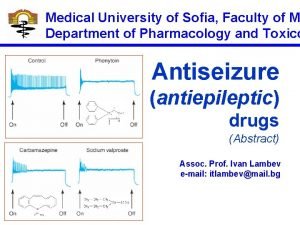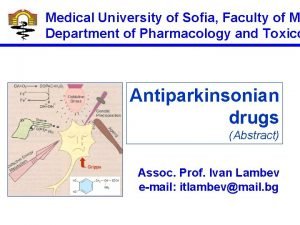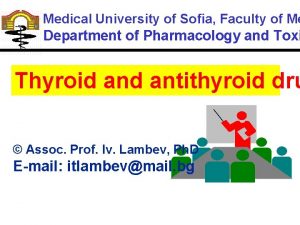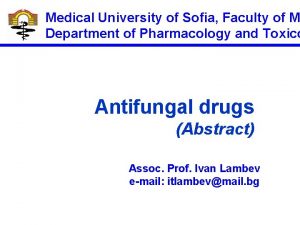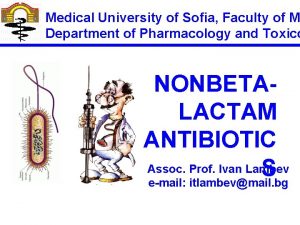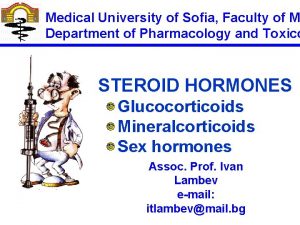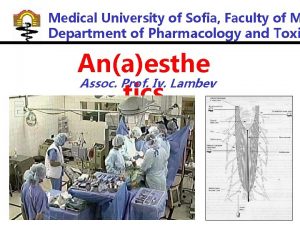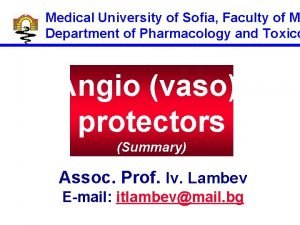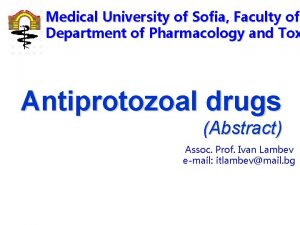Medical University of Sofia Faculty of Medicine Department






















































































- Slides: 86

Medical University of Sofia, Faculty of Medicine Department of Pharmacology and Toxicology • Quinolones • Oxiquinolones • Nitrofurans • Antiviral agents (Summary) Assoc. Prof. Ivan Lambev (www. medpharm-sofia. eu)

QUINOLONES (inhibitors of DNA gyrase, resp. inhibitors of topomerases) • Nalidixic acid and its derivatives • Fluoroquinolones

Nalidixic acid has been available for over 60 years but low activity poor tissue distribution, and adverse effects limited its use to being a second- and thirdline oral treatment for Gram (-) urinary tract infections.

Gr (—): E. coli Salmonella Shigella P. aeruginosa • Nalidixic acid ® (Nelidix ) ® • Gramurin

Changes to the basic quinolone structure such as the addition of fluorine and piperazine ring have dramatically increased antibacterial potency, particularly against P. aeruginosa. The new compounds are called 4 -fluoroquinolones (or fluoroquinolones)

Bactericidal effect • Gr (+): topoisomerase IV • Gr (–): topoisomerase II (DNA gyrase) Ciprofloxacin

Bacterial DNA topoisomerase II and IV) (- ) Fluoroquinolones

• Bactericidal effect; very broad antibacterial sp • High activity against P. aeruginosa, Salmonella, Shigella, Neisseria Campylobacter, and Chlamydia • Beta-lactamase stability • Limited activity against streptococci


>70% F (p. o. ) DD/2 applications Good intracellular distribution 50– 80%/24 h urinary excretion

INDICATIONS (infections): • urinary • respiratory • GIT • genital (incl. gonorrhoea) • septicemia • ophthalmic (topically)


CIPROFLOXACIN ® • Ciprobay tabl. 500 mg/12 h (5– 10 days)

• Co-administration of ciprof xacin and theophylline cau eleveted plasma theophylli concentrations due to inhib tion of cytochrome P 450. • Both drugs are epileptogen

Moxifloxacin Tabl. 400 mg NB: 400 mg once daily

• Gatifloxacin • Levofloxacin (Tavanic®) – S-isomer of ofloxacin 500 mg/24 h p. o. 10 days • Norfloxacin • Lomefloxacin • Ofloxacin • Pefloxacin • Trovafloxacin, etc.

Fluoroquinolones Adapted from Bennett and Brown (2003)

ADVERSE EFFECTS • convulsions (in patients with epilepsy or comm • arthritis (in growing animals) • dizziness • hepatic and renal damage • ruptura tendinorum in old people • crystallization (in excessively alkaline urine and dehydration) • cartilage damage. The mechanism of cartilage damage may be related to chelation of magnesium in joints.

The mechanism of cartilage damage may be rela to chelation of magnesium in joints. Lesions have been documented in dogs given five times the re mended dose and occur within 1– 2 days of begin administration. It is recommended that fluoroquin lones be avoided in large breed dogs up to 18 m of age (12 months for medium breeds, 9 months small breeds). If a fluoroquinolone must be used because there is no suitable alternative, strict ex restriction (especially for large breed dogs) and u of chondroprotectives are advised.

Contraindications • pregnancy • old people • epilepsy • meningitis • children

OXIQUINOLONES They block RNA polymerase. TILBROQUINOL – enteroantiseptic with antiamoebic activity NITROXOLIN – broad spectrum uroantiseptic (p. o. )

NITROFURANS – broad spectrum antibacterial agents FURAZOLIDONE, NIFUROXAZIDE – enteroantiseptics (Salmonella etc. ) NITROFURANTOIN (p. o. ) – uroantiseptic: E. coli, Proteus mirabilis, Staph. aureus, Klebsiella, Serratia, Pseudomonas. It blocks carbohydrate metabolism by inhibiting its acetyl Co. A synthes


Furazolidone

Nitrofurantoin ® (Furadantin ):

ANTIVIRAL AGENTS Viruses are composed of a core genome consisting o double-stranded or single-stranded DNA or RNA surr by a protein shell known as a capsid. Some viruses a further surrounded by a lipoprotein membrane or env Both the capsid and lipoprotein membrane may be a Viruses cannot replicate independently and must usu host’s metabolic machinery to replicate. Therefore vir are obligate intracellular parasites. The host’s pathwa energy generation, protein synthesis, and DNA or RN replication provide the virus with the means of viral re For some viruses, replication is initiated by viral enzy


Cells respond to viral infection in three ways: infection may have no impact on the cell or its function, cellular death may occur (which may preclude subsequ infection), or the cell may be transformed such that hos control of cell growth is lost to viral activities. Viral replication occurs in five or six sequential step • cell entry, including host cell attachment, generally thr specific receptors, followed by host cell penetration; • disassembly or uncoating resulting in release of viral g • transcription of viral genome (or viral messenger RNA which is dependent on virus-specified enzyme; • translation of regulatory (early) or structural (late) vira • post-translation modifications (incl. proteolytic cleavag • assembly of virion components; and release of the vir generally by budding or cell lysis.

TARGETS OF ANTIVIRAL THERAPY Potential targets in the viral life cycle that might be pharmacologically inhibited are expressed during extracellular stages of viral infection (i. e. , penetratio intracellular stages (i. e. , replication, assembly, and release), and dissemination. Antivirals that diminish penetration of host cells by the virus are more viral specific and less toxic from those that prevent viral replication. Because cell penetration is enhanced b viral-induced immunosuppression, pharmacologic immunomodulation (resp. immunostimulation) may help prevent viral penetration especially during the stages of infection, which are often missed because lack of clinical signs.

(Ag)

Cyclic amines inhibit influenza-A DNA replication. Rimantadine is from two to 8 -fold times more active than Amantadine.

Indications: prophylaxis and treatment of influenza A viral infection: А (H 5 N 1) (Flumadine ): • Rimantadine p. o. • Vitamin C • Esberitox N (immunostimulant)

Rimantadine adverse effects: • orthostatic hypotension • dizziness, confusion • headache, insomnia • vomiting, xerostomia • urinary retention

b) Neuraminidase inhibitors (active against virus A and B Zanamivir: • inhibits neuraminidase and prevents replication of influenza-A and B-virus • application: per inhalationem

Oseltamivir ® – Tamiflu against virus А, B A (H 5 N 1): bird or avian flu (influenza) – (2 s/78 °C) A (H 1 N 1): swine or pig flu (influenza) Treatment: 75 mg/12 h 5 days Prophylaxis: 75 mg/24 h about 30 days

Pig flu: Bird flu:







Symptomatic therapy

Paracetamol Metamizole

Please, give me something against influenz

Influenza Virus Vaccines (PRC Against virus А (H 5 N 1) Against virus – A (H 1 N 1) : • Fluarix ® • Celvapan • Fluogen ® • Focetria • Inflexal V ® • Pandemrix • Influvac ® • Prepandrix • Invivac • Vaxigrip • Vacciflu 0, 5 ml i. m. /deep s. c.


It is time to get vaccinated against influenza virus A (H 1 N 1)

, , Good humor helps enormously both in the study and practice of William Osler (1849 -1919) medicine. ”

2. INTERFERONS (IFNs) They are cytokines (mediators of cell growth and function). They are glycoproteins secreted by cells infected with viruses or foreign DNA.

Interferons are active against a wide range of viruses. Main types of IFNs: α – produced by leukocytes β – produced by fibroblasts γ – produced by lymphocytes

• IFN gamma has significant immunoregulatory function. • Interferon alfa-2 b (Intron ) is used in chronic hepatitis, Kaposi’s sarcoma in AIDS, multiple myeloma, etc. • Interferon beta-1 b (Betaferon ) used s. c. in multiple sclerosis (MS)

Adverse effects of IFNs • fever (influenza-like syndrome) • lympho- and thrombocytopenia • anorexia and weight loss • alopecia • confusion, tremor, and fits • transient hypotension • cardiac arrhythmias • hypothyroidism

3. Antiherpetic Drugs H. simplex They are prodrugs nucleoside analogues.

After phosphorylation nucleoside analogs conv into active metabolites, which inhibit viral DNA polymerase (reverse transcriptase) and block viral replication.

Indications: H. simplex and varicella-zoster infections • aciclovir • ganciclovir • valaciclovir • brivudine

Treatment of postherpetic neuralgi ●Anticonvulsants Gabapentin, Pregabalin ●Antidepressants Nortriptyline, Duloxetine Herpes zoster infection ●Opioid painkillers Tramadol

Acyclovir and Valacyclovir Acyclovir is is structurally similar to guanosine (purine nucleoside). Valacyclovir is an L-valyl ester prodrug of Efficacy of acyclovir depends on activation of the drug t monophosphate derivative by viral thymidine kinase. Su phosphorylation to the diphosphate and then triphospha mediated selectively by cells infected with herpesvirus. The formation of acyclovir-GTP results in the inhibition DNA polymerase and incorporation of acyclovir-GTP in DNA, which terminates viral DNA synthesis. The drug h greater affinity for viral (versus host) thymidine syntheta Antiviral activity of acyclovir is limited essentially to herpesviruses. The in vitro activity of acyclovir is 100 tim than of vidarabine.

Aciclovir (INN) Ointment or cream ophthalmicum 5% 5 g

Aciclovir Vials (fl. ) 250 mg i. v. In herpes simplex encefalitis: 10– 12. 5 mg/kg/8 h i. v. inf. 10 days

Ganciclovir is structurally similar to acyclovir. Its spectrum herpesvirus, with particular efficacy against cytomegalovi Resistance most commonly reflects point mutations or de in viral DNA, resulting in reduced formation of viral phosphotransferase. The primary ARs is myelosuppressi with neutropenia occurring in up to 40% and thrombocyto in 5– 20% of patients. Myelosuppression more commonly occurs with i. v. administration and is generally reversible by 1 week after discontinuation of therapy. Therapeutic use of ganciclovir includes cytomegalovirus retinitis, particularly in humans with AIDS. Ganciclovir is also used for treatment of any infection or prevention of infection (particularly in transplant recipients associated with cytomegalovirus.


4. Antiretroviral Drugs Indications: AIDS a) Nucleoside analogues (prodrugs – DNA polymerase inhibitors) • Abacavir, Didanozine, Inosine (? ) • Lamivudine, Stavudine, Zalcitabin • Zidovudine (AZT)

HIV infections • Blood products • Sexual secretions

The HIV lifecycle





Zidovudine analogue of thymidine AZT (azidothymidine - USA) ® • Retrovir caps. 100 mg

AZT-MP . . . AZT-TP MP - monophosphate TP - 3 -phosphate AZT (-) Viral DNA polymeras

Unwanted reactions Bone marrow suppression (anaemia in 15%) vomiting, fatigue, headache, insomnia

Zalcitabine • Oral bioavailabilty 86% • Urinary excretion 70%

Unwanted reactions • peripheral neuropathies in 23% of patients • stomatitis aftosa • skin rash • myopathy

ТМ Combivir – Lamivudine – Zidovudine Trizivir™ – Abacavir – Lamivudine – Zidovudine

Inosine (Isoprinosine) is a nucleoside analog which ca cytopathic effects of several viruses in culture. The me of antiviral activity appears to involve specific suppres viral m. RNA. Inosine does not appear to be as efficacio several antimetabolite antiviral compounds. Inosine ca induce T-cell differentiation similar to that induced by hormones, apparently by augmenting RNA synthesis. Thus Inosine may be more useful as an immunostimulant in immunodeficient patients.

b) Non-nucleoside analogues used in AIDS: • Еfavirenz • Nevirapine

c) HIV-protease inhibitors They prevent cleavage of protein precursors essential for HIV infection of new cells and viral replication. • Amprenavir, Indinavir, Nelfinavir, Ritonavir

Indinavir Ritonavir

d) Drugs, inhibiting HIV with target membrane of human cells ENFUVIRITIDE (Fuzeon®) – s. c. e) Integrase inhibitors – act on the gene lev RALTEGRAVIR

g) Infective complication of HIV-infections • Pneumocystis carinii pneumonia high dose co-trimoxazole (21 days i. v. is first-line standard therapy • Oropharyngeal candidiasis fluconazole (14 days p. o. ) • Tbc: M. avium complex (with Rifab

Feline Immunodeficiency Virus (FIV)

FIV can attack the immune system of cats, much like HIV can attack the immune system of human beings. FIV infects many cell types in its host, including CD 4+ and CD 8+ T lymphocytes, B lymphocytes, and macro FIV can be tolerated well by cats, but can eventually l debilitation of the immune system in its feline hosts by infection and exhaustion of T-helper (CD 4+) cells. FIV are both lentiviruses; however, neither can infect the usual host: humans cannot be infected by FIV nor can infected by HIV. FIV is transmitted primarily by way o and blood throwgh bite wounds during territorial battle between males. Cats housed exclusively indoors are less likely to be infected.

5. HPV vaccines: SILGARD®: 0, 2, and 6 month i. m. (from 9 to 26 years old) CERVARIX® HPV Cervarix®

HPV vaccines: SILGARD®: 0, 2, and 6 month i. m. (from 9 to 26 years old) CERVARIX® HPV may causes cance Cervarix®

Prof. G. Gorchev, MD, DSc, oncogynecologist, Medical University – Pleven
 Hubert kairuki memorial university faculty of medicine
Hubert kairuki memorial university faculty of medicine Solid thyroid nodule
Solid thyroid nodule King abdulaziz university faculty of medicine
King abdulaziz university faculty of medicine Territorial matrix vs interterritorial matrix
Territorial matrix vs interterritorial matrix Faculty of veterinary medicine cairo university logo
Faculty of veterinary medicine cairo university logo Hacettepe university faculty of medicine
Hacettepe university faculty of medicine دانشگاه دامپزشکی تهران
دانشگاه دامپزشکی تهران Semmelweis university faculty of medicine
Semmelweis university faculty of medicine Faculty of veterinary medicine cairo university
Faculty of veterinary medicine cairo university Cairo university faculty of veterinary medicine
Cairo university faculty of veterinary medicine Masaryk university medical faculty
Masaryk university medical faculty Masaryk university medical faculty
Masaryk university medical faculty Faculty of medicine nursing and health sciences
Faculty of medicine nursing and health sciences Department of medicine mcgill
Department of medicine mcgill Pubh4401
Pubh4401 Coumadin clinic emory
Coumadin clinic emory Nit calicut chemistry department
Nit calicut chemistry department Elearn sofia university
Elearn sofia university University of chemical technology and metallurgy sofia
University of chemical technology and metallurgy sofia Technical university sofia
Technical university sofia Technical university of sofia
Technical university of sofia Medical faculty in novi sad dean
Medical faculty in novi sad dean Herszon kherson maritime college of merchant marine fleet
Herszon kherson maritime college of merchant marine fleet University of bridgeport computer science
University of bridgeport computer science University of bridgeport computer engineering
University of bridgeport computer engineering Fsu computer science department
Fsu computer science department Mendel university faculty of business and economics
Mendel university faculty of business and economics Singularity university faculty
Singularity university faculty Feup university of porto
Feup university of porto Webkredit cuni
Webkredit cuni Faculty of law of the university of zagreb
Faculty of law of the university of zagreb University of montenegro faculty of law
University of montenegro faculty of law University of kragujevac faculty of technical sciences
University of kragujevac faculty of technical sciences University of cologne faculty of management
University of cologne faculty of management Leading university
Leading university Brown university computer science faculty
Brown university computer science faculty Roumieh university
Roumieh university York concurrent education
York concurrent education University of debrecen faculty of economics and business
University of debrecen faculty of economics and business Clemson electrical engineering
Clemson electrical engineering Faculty of mechanical engineering thammasat university
Faculty of mechanical engineering thammasat university Faculty of business and economics mendel university in brno
Faculty of business and economics mendel university in brno Faculty of public health mahidol university
Faculty of public health mahidol university University of pecs faculty of health sciences
University of pecs faculty of health sciences Faculty of education khon kaen university
Faculty of education khon kaen university Faculty of communication arts, chulalongkorn university
Faculty of communication arts, chulalongkorn university Department of medicine solna
Department of medicine solna Meritus primary care
Meritus primary care Babesuniversity
Babesuniversity Lincoln memorial university college of veterinary medicine
Lincoln memorial university college of veterinary medicine King faisal university college of medicine
King faisal university college of medicine King saud university college of medicine
King saud university college of medicine Prodofol
Prodofol Uw integrative medicine
Uw integrative medicine Victor babeş university of medicine and pharmacy
Victor babeş university of medicine and pharmacy Victor babes university of medicine and pharmacy
Victor babes university of medicine and pharmacy King saud university college of medicine
King saud university college of medicine Paten brno
Paten brno Slu ent residents
Slu ent residents Al mustansiriya university college of medicine
Al mustansiriya university college of medicine Midwestern university college of dental medicine
Midwestern university college of dental medicine Seoul national university medical school
Seoul national university medical school University of kentucky college of medicine
University of kentucky college of medicine Unm internal medicine residency
Unm internal medicine residency Mercer med library
Mercer med library University of arizona emergency medicine
University of arizona emergency medicine Medical records committee functions
Medical records committee functions Medical education and drugs department
Medical education and drugs department Department of law university of jammu
Department of law university of jammu Department of geology university of dhaka
Department of geology university of dhaka Mechanicistic
Mechanicistic University of bridgeport it department
University of bridgeport it department Isabel darcy
Isabel darcy Department of physics university of tokyo
Department of physics university of tokyo Texas state psychology program
Texas state psychology program Department of information engineering university of padova
Department of information engineering university of padova Department of information engineering university of padova
Department of information engineering university of padova Manipal university chemistry department
Manipal university chemistry department Syracuse university pool
Syracuse university pool Jackson state university finance department
Jackson state university finance department Webnis
Webnis Michigan state physics
Michigan state physics Columbia university cs department
Columbia university cs department University of sargodha engineering department
University of sargodha engineering department Stanford university philosophy department
Stanford university philosophy department Doctors license number
Doctors license number Gbmc infoweb
Gbmc infoweb











